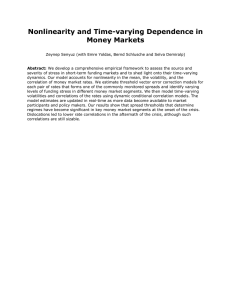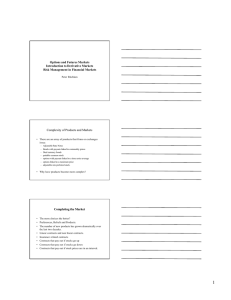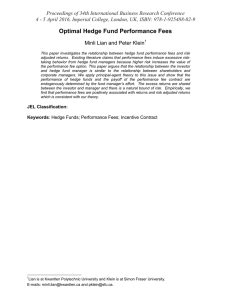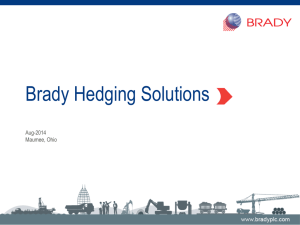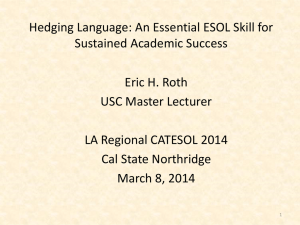of Statistical and Econometric Methods, vol.4, no.4, 2015, 91-126 Journal
advertisement
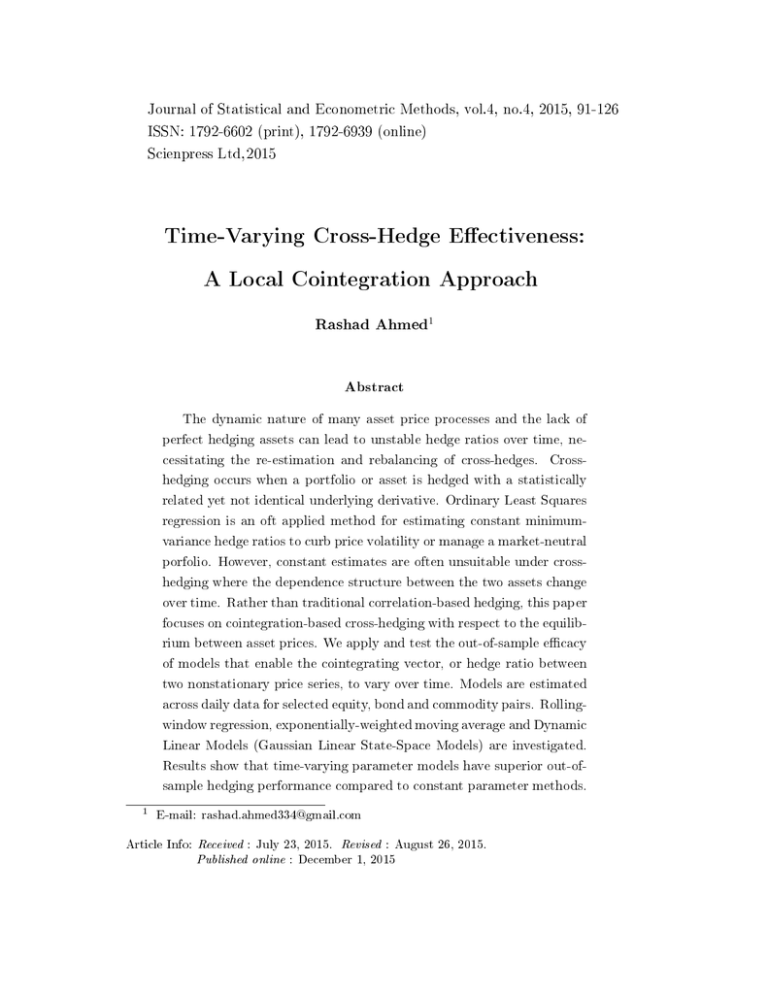
Journal of Statistical and Econometric Methods, vol.4, no.4, 2015, 91-126
ISSN: 1792-6602 (print), 1792-6939 (online)
Scienpress Ltd, 2015
Time-Varying Cross-Hedge Eectiveness:
A Local Cointegration Approach
Rashad Ahmed1
Abstract
The dynamic nature of many asset price processes and the lack of
perfect hedging assets can lead to unstable hedge ratios over time, necessitating the re-estimation and rebalancing of cross-hedges. Crosshedging occurs when a portfolio or asset is hedged with a statistically
related yet not identical underlying derivative. Ordinary Least Squares
regression is an oft applied method for estimating constant minimumvariance hedge ratios to curb price volatility or manage a market-neutral
porfolio. However, constant estimates are often unsuitable under crosshedging where the dependence structure between the two assets change
over time. Rather than traditional correlation-based hedging, this paper
focuses on cointegration-based cross-hedging with respect to the equilibrium between asset prices. We apply and test the out-of-sample ecacy
of models that enable the cointegrating vector, or hedge ratio between
two nonstationary price series, to vary over time. Models are estimated
across daily data for selected equity, bond and commodity pairs. Rollingwindow regression, exponentially-weighted moving average and Dynamic
Linear Models (Gaussian Linear State-Space Models) are investigated.
Results show that time-varying parameter models have superior out-ofsample hedging performance compared to constant parameter methods.
1
E-mail: rashad.ahmed334@gmail.com
Article Info:
Received : July 23, 2015. Revised : August 26, 2015.
Published online : December 1, 2015
92
Time-Varying Cross-Hedge Eectiveness: A Local Cointegration Approach
This nding is conrmed through extensive Monte Carlo simulation. In
practice, this reduction in basis risk comes with incurred transaction
costs from routine hedge reblancing.
Keywords: Market Neutral; Cointegration; Time-Varying Model; Dynamic
Linear Model; Kalman Filter; Hedging
1 Introduction
Ordinary Least Squares (OLS) regression is an oft applied statistical method
for estimating constant minimum-variance hedge ratios to curb price volatility
or manage a market-neutral portfolio. However, the dynamic nature of many
asset price processes and the lack of perfect hedging assets can lead to unstable hedge ratios over time, necessitating the re-estimation and rebalancing of
hedges. In practice, linear hedging between two assets can be estimated based
on the correlation across returns. Instead of correlated returns, this paper extends another common practice of hedging with cointegrated prices series. We
apply and test the out-of-sample hedge eectiveness of statistical models that
enable the cointegrating vector, or hedge ratio, to vary over time across various
nancial instruments. We investigate models with parameters that are allowed
to adapt while absorbing new information (or observations) in an on-line fashion, namely rolling window regression (RWR), exponentially weighted moving
average (EWMA) and Dynamic Linear Models (DLM - also known as Linear
Gaussian State-Space Models). The empirical analysis is conducted on daily
data from the following instruments, with hypothetical use-cases following:
Asset Class
Instrument
Hedge
Equities
Apple Stock (AAPL)
Powershares QQQ Trust (QQQ)
Bonds
High-Yielding Bond
Low-Yielding Bond
Commodities U.S. Gulf Coast Jet Fuel West Texas Intermediate Crude Oil Futures
Rashad Ahmed
93
Equities: A trader wishes to neutralize systematic risk to exploit the meanreverting spread between the stock and ETF
Bonds: A large bank hedges bond price volatility to capture the interest rate
dierential
Commodities: A commercial airline imperfectly hedges jet fuel price volatility by participating in highly liquid WTI crude oil futures markets
The im-
portance of eective hedging bears signicant relevance in portfolio and risk
management.
When constructing portfolios to mitigate certain risks or iso-
late particular exposures, maintaining market-neutrality is a challenging yet
important objective. Hedging linear relationships can be viewed as a regression problem, that is, we aim to minimize the variance of such a portfolio to
maximize the benets of correlation between the pair. The practical value of
hedging solutions has led to deep literature on this subject. Traditionally, constant hedge ratios are estimated via ordinary least squares (OLS) regression
on returns, with the slope coecient equaling the hedge ratio (e.g. Ederington (1979); Anderson and Danthine (1980)). However, this procedure is only
appropriate if the assumption of constant variance in the distribution of asset
returns holds true- an overwhelmingly large body of literature shows that it
does not. There is well established evidence of heteroskedasticity often encountered in asset returns (Park & Bera (1987)). This non-constant variance leads
to non-constant covariation in multivariate settings such as that of hedge estimation, therefore an interest in extending the traditional OLS hedging model
to those which can account for time-varying variance and covariation exists.
Triantafyllopoulos & Montana (2009) apply state-space modeling and Kalman
ltering in a real-time statistical arbitrage framework to capture the cointegrated nature between two exchange traded funds.
Park & Jei (2006) and
Bera et al (1997) studied the hedging eectiveness of corn and soybean futures
contracts on spot prices with bivariate GARCH models and found that the
variance of hedge ratios is inversely related to hedging eectiveness. Kroner &
Sultan (1993) also estimate time-varying hedge ratios for foreign exchange futures using a bivariate error correction model with a GARCH error structure.
The authors found that time-varying hedge ratios outperform the conventional
models both in-sample and out of sample. By applying various constant and
Time-Varying Cross-Hedge Eectiveness: A Local Cointegration Approach
94
time-varying hedge ratios to Indian stock and commodity futures markets,
Kumar et al.
(2008) nds further evidence of time-varying hedge ratios re-
ducing variance compared to constant hedge ratio models. Myers (1991) analyzes hedging in futures markets and concludes that both simple and relatively
complex models that take advantage of all relevant conditioning information
available to traders, e.g. time-varying parameter models lead to better hedging
compared to traditional OLS hedging.
While hedge ratios are traditionally constructed on asset returns due to
their stationary nature, we assess hedge ratios on prices under the local cointegration framework. Local cointegration, also dened as time-varying or functional cointegration, has been explored in the literature, though not as thoroughly as returns-based hedging. Park & Hahn (1999) model U.S. automobile
demand using cointegration with time-varying coecients, such that the coefcient evolves smoothly over time and is estimated nonparametrically. More
recently, Bierens & Martins (2010) apply time-varying vector error correction
models to the purchasing power parity hypothesis of international prices and
nominal exchange rates, and nd evidence of time-varying cointegration. The
authors estimate the time-varying coecients using Chebyshev time polynomials.
Xiao (2009) proposes a functional cointegration model, which allows
the cointegrating vector to vary stochastically through both kernel and local
polynomial estimation. Wagner (2010) applies cointegration in a state-space
setting. The objective of this paper is to provide further evidence of the utility
of time-varying models to manage nancial risk by applying three practical
models that allow the cointegrating vector to vary over time under the local
cointegration framework.
sion and cointegration.
The rst section briey discusses spurious regres-
The second section of this paper provides detail on
the three time-varying models of interest, namely rolling-window regression,
exponentially weighted moving average, and dynamic linear models. Section 3
summarizes the empirical analysis and performance evaluation. In this section,
daily, every other day, and weekly (5 day) hedge rebalancing performance are
evaluated with results documented for comparison between dynamic models
and against the traditional OLS. Results show that these methods can greatly
reduce the variance of the of the hedging model residuals, also known as basis
risk. This performance improvement, however, is only possible in a practice by
incurring increased transaction costs due to portfolio rebalancing. Section 4
Rashad Ahmed
95
contains extensive results from simulation studies to conrm the robustness of
model estimates and hedge eectiveness of locally cointegrating prices. Lastly,
we conclude with a summary of the research and ndings.
2 Overview of Cointegration
Cointegration, popularized by the work of Engle and Granger (1987), is a
model-free phenomenon which occurs when two (or more) stochastic processes
are non-stationary, but some linear combination of said processes is stationary.
{y1 , y2 , ...yp } denote a set of p vectors, each with an equal number of
observations t1 , t2, ...tT . Then the set p is said to be cointegrated if each vector
{y1 , y2 , ...yp } taken individually is I(1), e.g. integrated of order 1; a nonLet
stationary process that becomes stationary when dierenced once, while some
linear combination of the series
vector
γ.
γ 0p
is
I(0),
or stationary for some non-zero
Specically, a set of series, all integrated of order
n,
(in our case
integrated of order 1), are said to be cointegrated if and only if some linear
combination of the series, with non-zero weights, is integrated of order less
than
yt
n
and
(Murray, 1994). For example, take the bivariate case where processes
xt
both follow non-stationary random walks.
yt ∼ I(1),
xt ∼ I(1).
(2.1)
If these series are cointegrated, there exists
zt = yt − γxt
such that
zt
follows a stationary
I(0)
zt ∼ I(0),
process.
the cointegrating vector, can be estimated by
(2.2)
The
γ̂
γ
parameter, known as
via least-squares spurious
regression through the origin (note the lack of an intercept term) of one random
walk onto another:
yt = γ̂xt + zt .
(2.3)
Pt
xt yt
γ̂ = Pi=1
t
2
i=1 xt
(2.4)
96
Time-Varying Cross-Hedge Eectiveness: A Local Cointegration Approach
yt , xt , and zt can all be tested for unit roots (or lack thereof
in the case of zt if yt and xt are actually cointegrated) using statistical tests for
stationarity. The Engle-Granger Representation Theorem states that xt and
yt cointegrate if and only if there exists an error correction model (ECM) for
either xt , yt , or both. For example, let zt = yt − γ̂xt be a stationary relation
between I(1) variables as shown above. Then there exists a stationary ARMA
model for zt . Assume for simplicity an AR(2),
In application,
zt = φ1 zt−1 + φ2 zt−2 + t ,
φ(1) = 1 − φ1 − φ2 > 0.
(2.5)
This is equivalent to
(yt − γxt ) = φ1 (yt−1 − γxt−1 ) + φ2 (yt−2 − γxt−2 ) + t
(2.6)
yt = γxt + φ1 yt−1 − φ1 γxt−1 + φ2 yt−2 − φ2 γxt−2 + t ,
(2.7)
or
∆yt = γ∆xt + φ2 γ∆xt−1 − φ2 ∆yt−1 − (1 − φ1 − φ2 ){yt−1 − γxt−1 } + t .
(2.8)
Unlike hedging based on correlation, cointegration-based hedging provides
a robust alternative.
Correlated hedging requires assets to move in tandem
while cointegration implies that two price series cannot wander o in opposite
directions for very long without eventually reverting to a mean distance.
It
does not necessarily require that on a daily basis the two prices have to move
in synchrony - what it implies is that there exists some long run equilibrium
relationship between the two series.
2.1 Local Cointegration
The objective of this paper is to provide robust and practical evidence that
minimum-variance hedging based on prices can be improved by increasing the
exibility of our models. Specically, by allowing for time-varying covariance
structure between nonstationary price series, we capture information that lets
one routinely update their knowledge of the underlying process. In this paper,
Rashad Ahmed
97
we dene Local Cointegration as cointegration that holds under a time-varying
cointegrating vector, or simply,
zt+q = yt+q − γt xt+q
zt+q , ∼ I(0) yt+q ∼ I(1) xt+q ∼ I(1),
(2.9)
q denotes q -periods ahead. This can be be any number in theory, but we
study and assess the domain of q = {0, 1, 2, 5}. When q = 0, the cointegrating
vector updates contemporaneously while q > 0 holds a constant cointegrating
vector γt for q periods before updating. Under such circumstances, if the residual series zt is stationary, we dene the process as locally cointegrating. Even
where
if tests for constant cointegration fail (or marginally pass), the multivariate
process between two nonstationary series may be cointegrated under short durations which the time-varying nature of
γt
captures - leading to a stationary
residual series. Though structurally and intuitively simple, this time-varying
coecient approach to price-based hedging has valuable practical implications
for risk management and trading as evidenced by our study.
3 Time-Varying Parameter Models
Under theoretical assumptions of covariance-stationarity or xed long run
equilibria, constant model parameters can be estimated to determine whether
or not a cointegrating relationship exists to implement a hedge. Particularly
with nancial time series, these relationships and therefore static model parameter estimates are not constant. This introduces complexity to the estimation
problem. To estimate hedge performance of time-varying model parameters,
Rolling Window Regression (RWR), Exponentially Weighted Moving Average
(EWMA) models and Dynamic Linear Models (DLM) are investigated. In this
section we provide an overview of the models and how the cointegration-based
hedges are constructed.
3.1 Rolling Window Regression
Often referred to as the poor man's time-varying parameter model, a
rolling linear regression is simply the moving-average counterpart to linear
Time-Varying Cross-Hedge Eectiveness: A Local Cointegration Approach
98
regression.
For a window with
n < T,
the rolling window linear regression
(RWR) model may be expressed as (Zivot & Wang, 2003)
yt (n) = xt (n)γt (n) + zt (n),
t = n, ..., T,
(3.1)
yt (n) is an n × 1 vector of observations (asset prices) on the response,
xt (n) is an n × k matrix of explanatory variables (in our case, the n × 1 vector
of hedging asset's price observation), γt (n) is a k × 1 cointegrating vector (or
hedge ratio) and zt (n) is the n × 1 vector of stationary error/residual terms,
e.g. the hedge basis. The n observations are the n most recent observations
from time t − n + 1 to time t, akin to an n-period moving average, but here we
have an n period moving regression. The parameters can be estimated (Zivot
Where
& Wang, 2003) such that
γ̂t (n) = [xt (n)0 xt (n)]−1 xt (n)0 yt (n),
σ̂t2 (n) =
(3.2)
1
1
ẑt (n)0 ẑt (n) =
[yt (n) − xt (n)γ̂t (n)]0 [yt (n) − xt (n)γ̂t (n)],
n−k
n−k
(3.3)
V AR→∞ (γ̂t (n)) =
σ̂t2 (n)[xt (n)0 xt (n)]−1 .
(3.4)
3.2 Exponentially Weighted Moving Average
In terms of the traditional OLS model, the hedge ratio can be estimated as
γ̂ =
COV (xt , yt )
.
V AR(xt )
(3.5)
We apply this approach to determining time-varying hedge ratios in an exponentially weighted setting via EWMA. The unconditional covariance matrix
of our two series represented can be estimated as
T
Σ̂ =
where
Σ̂
1 X
(yt − ȳ)(xt − x̄),
T − 1 t=1
denotes the covariance matrix of
xt
and
yt .
(3.6)
Time-variation in the
Rashad Ahmed
99
covariance matrix is introduced by weighting more recent observations heavily
relative to past observations through exponential smoothing,
Σ̂t = (1 − λ)(yt − ȳ)(xt − x̄) + λΣ̂t−1 ,
"
Σ̂t =
where
of
0 < λ < 1is
y , x,
σ̂y2
σ̂xy
σ̂xy
σ̂x2
(3.7)
#
σ̂y2 , σ̂x2 and σ̂xy are the variance
time t, respectively. The larger λ,
the weight parameter,
and their covariance estimates at
the more weight is given to previous observations and less to the most recent
observation.
with
Financial risk institution
λ = 0.94,
RiskM etricsT M
implements EWMA
as we shall in our hedge performance testing. To initialize the
EWMA the estimate of the entire sample covariance matrix
For a given
Σ̂1 = Σ̂
is used.
λ and an initial estimate Σ̂1 , Σ̂t can be computed recursively.
the assumption that the joint distribution of the observed asset prices
Under
xt
and
yt , is multivariate normal with mean zero and covariance matrix Σt , where the
mean µt is a function of parameter Θ, then λ and Θ can be estimated jointly
via Maximum Likelihood because the log-likelihood function of the data is
T
T
1X
1X
|Σt | −
(yt − ȳ)(xt − x̄)0 Σ−1
ln L(Θ, λ) ∝ −
t (yt − ȳ)(xt − x̄),
2 t=1
2 t=1
which can be evaluated recursively by substituting
Σ̂t
for
Σt
(3.8)
(Tsay, 2010).
3.3 Dynamic Linear Models & The Kalman Filter
Dynamic Linear Models (Kalman ,1960 and Anderson & Moore, 1979) follow a Bayesian estimation philosophy for estimating time-varying parameters.
This method, theorized quite some time ago, has gained recent popularity
dude to advances in technology and computing power. Recent treatments of
Dynamic Linear Models and Kalman Filtering (Kalman, 1960) were developed
in 2001 (see Durbin & Koopman, 2001). The idea is that an observation
at time
t
depends on an underlying
dependent variable
Xt .
We treat
γt
state vector (hedge ratio)
γt
yt
and the in-
as a random state rather than a constant
100
Time-Varying Cross-Hedge Eectiveness: A Local Cointegration Approach
coecient as done in simple linear regression, and this state can vary over time.
Under the Kalman Filter, this is a Gaussian Process where the joint distribu-
(...γt−2 , γt−1 , γt , γt+1, γt+2 ..., γt−2 , γt−1 , y, yt+1 , yt+2 , ...)
tion of all parameters
is
multivariate normal. The Gaussian assumption can be relaxed under extensions of the Kalman Filter such as the Particle Filter. We refer the reader to
Bishop (2006) and Kitagawa & Gersch (1996) for further treatment of ltering
methods.
Modied from Tsay's (2010) treatment of state-space models and
the Kalman Filter, the linear Gaussian state-space DLM can be written as a
hierarchical model given by
zt ∼ N (0, P ),
yt = αt + γt xt + zt ,
wt ∼ N (0, Qw ),
αt = Rα + wt
zt , wt
and
ut
(3.10)
ut ∼ N (0, Qu ),
γt = T γt−1 + ut ,
such that
(3.9)
(3.11)
are two independent Gaussian white noise series, and
are independent of both
E(yt ), E(αt )
and
E(γt )
at time
t > 0,
respectively.
The estimation of the parameters that specify a Dynamic Linear Model is quite
involved. Taken from Shumway & Stoer (2000), here we use Maximum Like-
θ denotes the parameter
1 , 2 , ..., n dened by
lihood Estimation (MLE), where
is computed using innovations
set. The likelihood
zt = yt − E(yt |yt−1 ) = yt − αt − γt Xtt−1 ,
with covariance matrix
Σt = var(zt ).
Ignoring the constant, we can write the
log likelihood function to be maximized,
n
(3.12)
LY (θ)
as
n
1X
1X
−lnLY (θ) =
log|Σt (θ)| +
zt (θ)0 Σt (θ)−1 z(θ).
2 t=1
2 t=1
(3.13)
Solving this function is not a trivial task, hence various recursive and algorithmic approaches have been presented (Gupta and Mehra,1974). For deeper
detail, we refer the reader to Shumway & Stoer (2000).
DLM parameters can be estimated with the Kalman Filter, a forwardsbackwards recursive algorithm. Essentially, the Kalman Filter is the continuousstate-space analogue of the Hidden Markov Model, which deals with a discrete
state-space. For extensive treatment of the Kalman Filter algorithm there is
Rashad Ahmed
101
deep literature on the subject, one referral is Kitagawa & Gersch (1996). The
following is a high level treatment of the Kalman Filter algorithm, taken from
West & Harrison (1997).
The Generation Step
αt = 0. At time t, calculate a prior
mean and variance for the quantities at time t. The expectation of γt at time
t is bt so the expectation of γt at time t − 1 is bt|t−1 = Tt bt−1 . The value of the
Without loss of generality, suppose
state vector is not observable, but at any time there exists a mean vector and
γt at time t is St , so the variance of
0
Tt St−1 Tt + Qt . At time t − 1 the expectation of Yt is
covariance matrix for it. The variance of
γt
at time
t − 1 is St|t−1 =
the variance of
yt
Ft = xt bt|t−1 ,
(3.14)
Dt = xt St|t−1 x0t + Pt ,
(3.15)
is
and the covariance of
γt
and
Yt
is
Ct = St|t−1 x0t .
So, at time
(3.16)
t − 1,
E
γt
yt
and
γt
V ar
yt
!
=
!
=
bt|t−1
Ft
!
,
!
St|t−1 Ct
.
Ct0
Dt
(3.17)
(3.18)
The Observation Step
At time t,
yt is observed.
Beliefs about
γt are updated.
Under the Gaussian
assumption, then this is done by applying Baye's rule. The updated mean for
γt
is
bt = bt|t−1 + Ct Dt−1 (yt − Ft ),
(3.19)
Time-Varying Cross-Hedge Eectiveness: A Local Cointegration Approach
102
and the updated variance matrix for
γt
is
St = St|t−1 − Ct Dt−1 Ct0 .
Note that the variance matrices
have
t
subscripts,
P, Q, x,
and
T
(3.20)
Pt and Qt are known/given.
Although they
would often remain constant.
Updating
When some new data is observed, rst a generation step then an observation
step is carried out to update the state vector.
Forecasting
A generation step on its own gives a one-step-ahead forecast. Forecasts can
be generated further into the future by a sequence of generation steps without
observation steps. For example, suppose the data at time
t
is observed. One-
step-ahead forecasts can be found.
E
γt+1
yt+1
and
γt+1
V ar
yt+1
!
=
!
=
!
T bt
,
xT bt
St+1|t Ct+1
0
Dt+1
Ct+1
(3.21)
!
.
(3.22)
Then the two-step ahead forecasts can be calculated, and so on.
E
and
γt+2
V ar
yt+2
γt+1
yt+1
!
=
!
=
!
!
T 0
T bt
=
xT 0
xT bt
!
T T bt
,
xT T bt
!
!
!
T 0
St+1|t Ct+1
T 0 T 0 x0
.
0
xT 0
0
0
Ct+1
Dt+1
(3.23)
(3.24)
Alternative derivations of the Kalman Filter algorithm can be found extensively in the literature (Tsay 2010, Bishop 2006, Kitagawa & Gersch 1996,
are just a few that we refer to). By implementing DLM, functional coecients
Rashad Ahmed
103
will enable the modeling of dynamic systems. By estimating a functional cointegrating vector, the relationship between two non-stationary series can be
considered dynamic, and an optimal hedge can be generated when traditional
models are not suitable.
4 Empirical Analysis & Testing Hedge Eectiveness
In this section, we discuss the applications of time-varying hedges and the
data
2
on which it will be tested upon.
Out-of sample testing is done on 3
pairs of assets from dierent markets.
The equity market pair consists of
the NASDAQ index tracking exchange-traded fund (QQQ) and Apple, Inc.
stock (AAPL). With AAPL being a constituent of the QQQ itself, the two
equity assets bear considerable correlation in their return series. For xed income markets, exchange traded funds iShares iBoxx High Yield Corporate Bd
(HYG) and iShares Core US Aggregate Bond (AGG) are used. A trader aiming to capture the nominal yield dierential between the two bond portfolios,
or more generally high-yield and investment-grade bonds, could go long HYG
and hedge the market risk with AGG. From the commodities space we model
the hedge ratio between West Texas Intermediate Crude Oil Front-Month Futures and U.S. Gulf Coast Jet Fuel Spot prices. WTI Crude futures, being one
of the most liquid energy markets globally, provides ease of hedging against
uctuating Jet Fuel prices, and other petroleum-based products that may not
have liquid futures markets, given that these products exhibit structural dependency.
A Fast Rolling-Window Regression (RWR) is implemented with a window size of
n = 2.
As such, the hedge ratio is eectively the slope between
the two most recent observations.
Empirically, this small window size out-
performs longer window sizes. The Exponentially Weighted Moving Average
2 AAPL
& QQQ daily prices were collected from Yahoo! Finance, dating from 4/1/2005
to 4/1/2015.
HYG & AGG daily prices were also taken from Yahoo!
Finance, dating
from 4/11/2007 to 4/1/2015. WTI Crude Oil Front Month Futures prices were taken from
Quandl, Inc.
and the Wiki Continuous Futures Database.
U.S. Gulf Coast Jet Fuel spot
prices are sourced from the U.S. Department of Energy. The two energy price series consist
of daily data dating from 4/1/2005 to 4/1/2015.
Time-Varying Cross-Hedge Eectiveness: A Local Cointegration Approach
104
model will hold a decay parameter
TM
set byRiskM etrics
λ = .94,
which is the industry standard
. As mentioned, the initial observation variance for the
Dynamic Linear Model (DLM) is estimated using Maximum-Likelihood based
optimization and the state variance is set to 1. The out-of sample testing is
based on three scenarios: daily rebalancing, rebalancing every 2 days, and rebalancing every 5 days (or business week). No contemporaneous information is
used to estimate hedge ratios to satisfy out-of-sample requirements such that
the general model follows the equation
yt+k = γ̂t xt+k + zt+k .
The hedge ratio
γ̂
(4.1)
is estimated recursively, using only data up to but not
including the current value for the one-step ahead test, e.g.
the estimated
γ̂
k = {1}.
Similarly,
k = {1, 2} when rebalancing every two days. Weekly
by estimating γ̂ using k = {1, 2, 3, 4, 5} such that the
uses data
rebalancing is emulated
hedge ratio estimate is carried forward throughout the 5 day period before
re-estimating and repeating. Why not rebalance daily and minimize the basis
variance? Simply because of the practical costs of trading incurred with daily
rebalancing. Rebalancing every 2 days would hypothetically increase the basis
risk, though cost of hedging would be cut in half. Rebalancing weekly would
further reduce costs of hedging. For these out-of-sample tests, the statistics for
performance evaluation are the Root Mean Squared Error and Mean Absolute
Deviation,
v
u
n
u1 X
t
RM SE =
(
ŷt − yt )2 ,
n i=1
(4.2)
n
1X
|ŷt − yt |,
M AD =
n i=1
where
ŷt
(4.3)
is the model tted value at time t. We omit the rst 500 observations
from the out-of-sample analysis as a burn-in phase for the models, namely
EWMA and DLM which estimate recursively. The remaining 8 years of daily
observations are used for testing hedge eectiveness.
Hedging eectiveness
under the classic OLS / Spurious Regression framework is shown in Table 1.
With AAPL trading in the $100's, HYG trading in the $50's and Jet Fuel
trading in the $2's, in-sample deviation statistics are roughly 10% across the
Rashad Ahmed
105
Table 1: Constant Estimates (OLS), in-sample RMSE/MAD
Pair
OLS Equation
RMSE
MAD
AAPL & QQQ
AAP L = −36.56 + 1.459QQQ
10.95
9.10
HYG & AGG
HY G = −43.09 + 1.584AGG
5.82
4.913
Jet Fuel & WTI
Jet = 0.017 + 0.029W T I
0.21
0.16
board.
Tables 2 to 4 show hedge eectiveness for the pairs under a time-
varying framework.
The hedge ratios of AAPL/QQQ and HYG/AGG are
characterized by heavy drift, suggesting that the dependence structure changes
considerably over time. Jet Fuel/WTI, however, has a relatively stable timevarying hedge ratio, implying that the relationship between the two petroleum
derivatives is structural and that the relationship could be modeled with a
static model reliably (evidence that the two series are truly cointegrated).
A peculiar benet of cointegration-based hedging with price series is that
the
RM SE
and
M AD
can be interpreted in dollar terms which lets us attach
a hard value to the basis risk. All three models vastly outperform even the insample performance of the static OLS model, while the simple RWR performs
surprisingly well and DLM outperforms under all rebalancing schemes. The
resulting residual
zt
based on time-varying models are all highly stationary,
with ADF tests rejecting the null hypothesis of a unit-root in all cases
0, 1, 2, 5)
across all models.
Table 2: AAPL & QQQ
RMSE
k=1 k=2 k=5
MAD
k=1 k=2 k=5
RWR
0.83
0.98
1.37
RWR
0.52
0.61
0.85
EWMA
2.16
2.23
2.41
EWMA
1.51
1.55
1.68
DLM
0.74
0.94
1.34
DLM
0.46
0.57
0.81
(k =
106
Time-Varying Cross-Hedge Eectiveness: A Local Cointegration Approach
Table 3: HYG & AGG
RMSE
k=1 k=2 k=5
MAD
k=1 k=2 k=5
RWR
0.49
0.57
0.77
RWR
0.34
0.40
0.54
EWMA
1.08
1.11
1.19
EWMA
0.86
0.88
0.95
DLM
0.44
0.54
0.75
DLM
0.31
0.37
0.52
Table 4: Jet Fuel & WTI Futures
RMSE
k=1 k=2 k=5
MAD
k=1 k=2 k=5
RWR
0.06
0.08
0.08
RWR
0.03
0.04
0.04
EWMA
0.10
0.10
0.11
EWMA
0.06
0.06
0.07
DLM
0.06
0.08
0.08
DLM
0.03
0.03
0.04
5 Simulation
To conrm the robustness of our out-of-sample performance, we ret and
evaluate the RMSE and MAD statistics based on simulated sample distributions of the statistics. For each pair of securities, 10,000 bootstrapped samples
were tested. Results were unanimously positive, conrming the reliability of
the out-of-sample RMSE and MAD statistics reported in Section 3.
Since
time series data is subject to potential short-memory / autoregressive characteristics, we take a Stationary Block Bootstrap (Politis & Romano, 1994)
approach. Traditional Monte Carlo bootstrapped simulation relies on the assumption that observations are independently and identically distributed, thus
the data could be randomly sampled with replacement.
Block Bootstrap is
more appropriate for time series since the observations are split into blocks of
a selected length, with the blocks rather than individual observations resampled. Stationary Block Bootstrap extends the Block Bootstrap in that rather
than xing the block length, it is allowed to vary such that the block length is
random and generated from a geometric distribution with some mean number
Rashad Ahmed
107
of observations per block - the specied mean block length for this study is 5.
The process undertaken runs over the following steps, for each asset pair:
1. Transform price series pair to logged returns (for stationarity and removing
long-memory).
2. Apply Stationary Block Bootstrap and generate a replicate, resampled with
replacement, with an equal number of daily observations as original data (10
years).
3.
Transform the multivariate series back to normalized price series, with
initial value of 1 by taking cumulative products.
4. Re-scale price series to original values by multiplying series by price at time
period 1.
5. Evaluate 1-day, 2-day, and 5-day out-of-sample RMSE and MAD statistics
for each replicate, for all three models: RWR, EWMA, DLM.
6. Repeat steps 2 through 5 10,000 times.
Out of sample performance from Section 3 matches bootstrapped mean
and median statistics closely, with the bootstrapped estimates being slightly
more conservative. The bootstrapped statistics have the benet of letting us
observe the full sampling distribution of hedge eectiveness under simulated
environments, and robustness of applying time-varying hedge models can be
conrmed. Note that these gures can be interpreted in dollar terms. Though
RWR performs second best, it is by far the slowest with respect to computation
- taking nearly 10 times longer than EWMA, the fastest simulation.
DLM
computation takes about 3 times as long as EWMA. When speed is a necessity,
the slight under performance of EWMA may be overlooked for its ease of
3
computation . Simulation results can be found in section 6, with histograms
in the Appendix A.
6 Conclusion
Time-varying cointegration models for hedging provide unique insights and
practical benets in markets where cross-hedges are needed. We test and nd
that Dynamic Linear Models prove to be the best performing modeling scheme
3 Computations
and Simulations were done in the R Statistical Language.
108
Time-Varying Cross-Hedge Eectiveness: A Local Cointegration Approach
in terms of stationarity in the residuals, root mean squared error and mean
absolute deviation metrics.
Rolling Window Regression and Exponentially
Weighted Moving Average methods also performed well, with all three models vastly outperforming the static hedge benchmark out-of-sample. EWMA
method, though under performed on a relative basis, has the fastest computation time. By treating price series as locally cointegrating, the application
of relatively simple yet robust models enable the practitioner to meaningfully
reduce basis risk, improving the practice of cross-hedging when traditional
hedging derivatives are not available or not applicable.
Rashad Ahmed
109
7 Simulation Results
Table 5:
AAPL & QQQ
[RWR]
Statistic
Min
1st Qu.
Median
Mean
3rd Qu.
Max
1-Day RMSE
0.03
0.34
0.64
1.00
1.21
21.84
1-Day MAD
0.02
0.21
0.37
0.55
0.68
11.48
2-Day RMSE
0.03
0.39
0.75
1.19
1.43
25.76
2-Day MAD
0.02
0.25
0.44
0.66
0.80
13.56
5-Day RMSE
0.05
0.54
1.02
1.61
1.94
36.42
5-Day MAD
0.03
0.34
0.61
0.90
1.12
19.70
[EWMA]
Statistic
Min
1st Qu.
Median
Mean
3rd Qu.
Max
1-Day RMSE
0.06
0.89
1.64
2.63
3.13
60.30
1-Day MAD
0.04
0.62
1.11
1.67
2.03
30.14
2-Day RMSE
0.06
0.92
1.67
2.71
3.22
62.12
2-Day MAD
0.05
0.64
1.15
1.72
2.09
31.04
5-Day RMSE
0.07
0.99
1.82
2.92
3.47
67.27
5-Day MAD
0.05
0.69
1.24
1.86
2.25
33.64
[DLM]
Statistic
Min
1st Qu.
Median
Mean
3rd Qu.
Max
1-Day RMSE
0.03
0.31
0.57
0.92
1.09
34.80
1-Day MAD
0.02
0.19
0.33
0.50
0.60
16.91
2-Day RMSE
0.03
0.38
0.70
1.13
1.34
37.42
2-Day MAD
0.02
0.23
0.41
0.61
0.74
17.86
5-Day RMSE
0.04
0.54
0.99
1.56
1.87
42.32
5-Day MAD
0.03
0.33
0.58
0.87
1.05
20.36
110
Time-Varying Cross-Hedge Eectiveness: A Local Cointegration Approach
HYG & AGG
Table 6:
[RWR]
Statistic
Min
1st Qu.
Median
Mean
3rd Qu.
Max
1-Day RMSE
0.30
0.59
0.71
0.75
0.87
2.54
1-Day MAD
0.18
0.36
0.44
0.45
0.53
1.35
2-Day RMSE
0.36
0.70
0.84
0.88
1.02
3.05
2-Day MAD
0.21
0.43
0.52
0.54
0.63
1.61
5-Day RMSE
0.48
0.94
1.013
1.18
1.37
4.32
5-Day MAD
0.28
0.59
0.71
0.74
0.86
2.30
[EWMA]
Statistic
Min
1st Qu.
Median
Mean
3rd Qu.
Max
1-Day RMSE
0.68
1.48
1.80
1.88
2.19
6.71
1-Day MAD
0.47
1.08
1.31
1.37
1.60
4.82
2-Day RMSE
0.70
1.52
1.85
1.93
2.25
6.90
2-Day MAD
0.48
1.11
1.35
1.41
1.64
4.96
5-Day RMSE
0.75
1.64
1.99
2.09
2.43
7.47
5-Day MAD
0.52
1.20
1.45
1.52
1.77
5.36
[DLM]
Statistic
Min
1st Qu.
Median
Mean
3rd Qu.
Max
1-Day RMSE
0.22
0.54
0.66
0.68
0.80
2.32
1-Day MAD
0.13
0.33
0.39
0.41
0.47
1.21
2-Day RMSE
0.27
0.66
0.80
0.83
0.96
2.80
2-Day MAD
0.16
0.39
0.48
0.49
0.57
1.47
5-Day RMSE
0.38
0.91
1.10
1.15
1.34
4.02
5-Day MAD
0.23
0.56
0.68
0.71
0.83
2.10
Rashad Ahmed
111
Table 7:
Jet Fuel & WTI Futures
[RWR]
Statistic
Min
1st Qu.
Median
Mean
3rd Qu.
Max
1-Day RMSE
0.0015
0.0182
0.0300
0.0421
0.0504
1.7520
1-Day MAD
0.0006
0.0093
0.0155
0.0216
0.0263
0.6343
2-Day RMSE
0.0017
0.0213
0.0351
0.0492
0.0591
1.9760
2-Day MAD
0.0008
0.0109
0.0181
0.0253
0.0308
0.7380
5-Day RMSE
0.0023
0.0281
.0465
0.0653
0.0784
2.7520
5-Day MAD
0.0011
0.0147
0.0245
0.0342
0.0418
1.0700
[EWMA]
Statistic
Min
1st Qu.
Median
Mean
3rd Qu.
Max
1-Day RMSE
0.0036
0.0426
0.0695
0.0977
0.1177
3.304
1-Day MAD
0.0025
0.0267
0.0446
0.0620
0.0754
1.874
2-Day RMSE
0.0037
0.0437
0.0714
0.1005
0.1210
3.387
2-Day MAD
0.0025
0.0274
0.0459
0.0637
0.0775
1.925
5-Day RMSE
0.0040
0.0470
0.0769
0.1081
0.1300
3.625
5-Day MAD
0.0027
0.0295
0.0494
0.0686
0.0835
2.072
[DLM]
Statistic
Min
1st Qu.
Median
Mean
3rd Qu.
Max
1-Day RMSE
0.0013
0.0165
0.0272
0.0381
0.0456
1.5880
1-Day MAD
0.0005
0.0082
0.0137
0.0191
0.0233
0.5557
2-Day RMSE
0.0016
0.0199
0.0328
0.0461
0.0554
1.5870
2-Day MAD
0.0007
0.0100
0.0167
0.0233
0.0284
0.6400
5-Day RMSE
0.0023
0.0272
.0450
0.0633
0.0762
2.7410
5-Day MAD
0.0010
0.0140
0.0234
0.0327
0.0399
1.0150
112
Time-Varying Cross-Hedge Eectiveness: A Local Cointegration Approach
Appendix A: Simulated RMSE / MAD Distributions
Figure 1: AAPL & QQQ : RWR
Rashad Ahmed
113
Figure 2: APPL & QQQ: EWMA
114
Time-Varying Cross-Hedge Eectiveness: A Local Cointegration Approach
Figure 3: AAPL & QQQ: DLM
Rashad Ahmed
115
Figure 4: HYG & AGG: RWR
116
Time-Varying Cross-Hedge Eectiveness: A Local Cointegration Approach
Figure 5: HYG & AGG: EWMA
Rashad Ahmed
117
Figure 6: HYG & AGG: DLM
118
Time-Varying Cross-Hedge Eectiveness: A Local Cointegration Approach
Figure 7: Jet Fuel & WTI Futures: RWR
Rashad Ahmed
119
Figure 8: Jet Fuel & WTI Futures: EWMA
120
Time-Varying Cross-Hedge Eectiveness: A Local Cointegration Approach
Figure 9: Jet Fuel & WTI Futures: DLM
Rashad Ahmed
121
Appendix B: Time-Varying Coecient Estimates
Figure 10: AAPL & QQQ
122
Time-Varying Cross-Hedge Eectiveness: A Local Cointegration Approach
Figure 11: HYG & AGG
Rashad Ahmed
123
Figure 12: Jet Fuel & WTI Futures
124
Time-Varying Cross-Hedge Eectiveness: A Local Cointegration Approach
References
[1] Anderson, Brian D.O. and Moore, John B.,
Optimal Filtering, New York,
Prentice Hall, pp. 129-133, 1979.
[2] Anderson, Ronald W., and Jean-Pierre Danthine, Cross Hedging,
Journal
of Political Economy J POLIT ECON, 89.6, (1981), 1182.
[3] Bera, A.K., Garcia, P. and Roh, J.S., Estimation of time-varying hedge ratios for corn and soybean: BGARCH and random coecient approaches,
Sankhya, 59, (1997), 346-368.
[4] Bierens, Martins,
Time Varying Cointegration, Econometric Theory, p.
1-38, 2010.
[5] Bishop, Christopher M.,
Pattern Recognition and Machine Learning, New
York, Springer, 2006.
[6] Durbin, J., and S. J. Koopman,
Time Series Analysis by State Space
Methods, Oxford, Oxford UP, 2001.
[7] Ederington, Louis H., The Hedging Performance of the New Futures Markets,
The Journal of Finance, 34(1), (1979).
[8] Engle, Robert F. and Granger, Clive W.J., Co-integration and error correction:
Representation, estimation and testing,
Econometrica, 55(2),
(1987), 251-276.
[9] Gupta, N., and R. Mehra, Computational Aspects of Maximum Likelihood Estimation and Reduction in Sensitivity Function Calculations,
IEEE Transactions on Automatic Control IEEE Trans. Automat. Contr.,
19(6), (1974), 774-783.
[10] Kalman,
R.E.,
tion Problems,
A
New
Approach
to
Linear
Filtering
and
Predic-
Journal of Basic Engineering, 82(1), (1960), 35-45,
doi:10.1115/1.3662552.
[11] Kitagawa, G., and Will Gersch,
ries, New York, Springer, 1996.
Smoothness Priors Analysis of Time Se-
Rashad Ahmed
125
[12] Kroner, Kenneth F., and Jahangir Sultan, Time-Varying Distributions
and Dynamic Hedging with Foreign Currency Futures,
The Journal of
Financial and Quantitative Analysis, 28(4), (1993).
[13] Kumar, Brajesh, Priyanka Singh, and Ajay Pandey, AHedging Eectiveness of Constant and Time Varying Hedge Ratio in Indian Stock and
Commodity Futures Markets,
SSRN Journal SSRN Electronic Journal,
(2008).
[14] Murray, Michael P., A Drunk and Her Dog: An Illustration of Cointegration and Error Correction,
The American Statistician, 48(1), (1994),
37.
[15] Myers, R.J., Estimating Time Varying Optimal Hedge Ratios on Future
Markets,
Journal of Futures Markets, 11, (1991), 39-53.
[16] Park, H.Y and A.K. Bera, Interest-Rate Volatility, Basis Risk and Heteroskedasticity in Hedging Mortgages,
AREUEA Journal, 5, (1987), 79-
97.
[17] Park, Sung Yong, and Sang Young Jei, Estimation and Hedging Eectiveness of Time-varying Hedge Ratio: Flexible Bivariate Garch Approaches,
J. Fut. Mark. Journal of Futures Markets, 30(1), (2010), 71-99.
[18] Park, Hahn,Cointegrating Regressions With Time Varying Coecients,
Econometric Theory, 15, (1999).
[19] Politis, Dimitris N., and Joseph P. Romano, The Stationary Bootstrap,
Journal of the American Statistical Association, 89(428), (1994), 13031313.
[20] Shumway, Robert H., and David S. Stoer,
Time Series Analysis and Its
Applications, New York, Springer, 2000.
[21] Triantafyllopoulos, K., and G. Montana, Dynamic Modeling of Meanreverting Spreads for Statistical Arbitrage,
Computational Management
Science, 8(1-2), (2011), 23-49.
[22] Tsay, Ruey S.,
Analysis of Financial Time Series, New York, Wiley, 2010.
126
Time-Varying Cross-Hedge Eectiveness: A Local Cointegration Approach
[23] Wagner, Martin, Cointegration Analysis with State Space Models,
AStA
Advances in Statistical Analysis, 94(3), (2010), 273-305.
[24] West, M. and Harrison, J.,
Bayesian Forecasting and Dynamic Models,
(2nd ed.), New York, Springer, 1997.
[25] Xiao, Zhijie, Quantile Cointegrating Regression,
Journal of Econometrics,
150(2), (2009), 248-260.
[26] Xiao, Zhijie, Functional-Coecient Cointegration Models,
Journal of
Econometrics, 152, (2009), 81-92.
[27] Zivot, Eric, and Jiahui Wang,
Modeling Financial Time Series with S-
Plus, New York, Springer, 2003.

